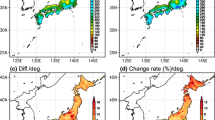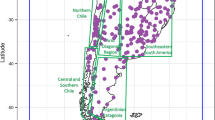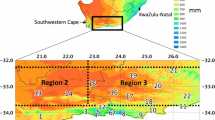Abstract
Reanalysis is well known for reliable reproduction of weather and climate. However, there is a dearth of information on the reliability of reanalysis in reproducing rainfall distribution over mountains during weak-synoptic conditions, when the deep convections are mostly triggered by small-scale circulations that are not usually explicitly resolved in reanalysis models. The present study examines the capability of the Climate Forecast System Reanalysis (CFRS) to represent rainfall patterns over the Drakensberg mountains on weak-synoptic days (WSDs) and investigates the extent to which the dynamic downscaling of the CFRS simulation with the Weather Research and Forecasting (WRF) model can improve the quality of the simulated rainfall fields. The self-organizing map (SOM) analysis was used to identify the major rainfall patterns over the Drakensberg and the WRF model was used to downscale the atmospheric condition associated with each pattern. The results reveal that the WSDs are induced by the presence or ridging of high-pressure system over the mountains. In agreement with observation, CFSR simulation showed that wet WSDs contributes up to 5% of the annual rainfall over the Drakensberg, but the simulation underestimates the frequency of the wet WSDs. It also underestimates the magnitude of the major WSD rainfall patterns over the Drakensberg: (1) heavy precipitation over the whole Drakensberg domain; (2) weak precipitation over the domain; (3) moderate precipitation over the southwest part; and (4) moderate precipitation over the north-eastern part of the domain. The dynamic downscaling of CFSR simulation with WRF improves the quality of CFSR rainfall products, although the magnitude of the improvement does not increase linearly with higher horizontal grid resolution in the WRF simulations. The results of the study have application in improving rainfall prediction over the Drakensberg.










Similar content being viewed by others
References
Abatan A, Collins M, Babel M, Khadka D, Silva Y (2023) Sub-seasonal to seasonal drivers of dry extreme rainfall events over Northeast Thailand. Front Clim 4:1031226. https://doi.org/10.3389/fclim.2022.1031226
Abiodun BJ, Prusa JM, Gutowski WJ (2008) Implementation of a non-hydrostatic, adaptive-grid dynamics core in CAM3. Part I: comparison of dynamics cores in aqua-planet simulations. Clim Dyn 31:795–810. https://doi.org/10.1007/s00382-008-0381-y
Abiodun BJ, Adegoke J, Abatan AA, Ibe CA, Egbebiyi TS, Engelbrecht F, Pinto I (2017) Potential impacts of climate change on extreme precipitation over four African coastal cities. Clim Change 143(3):399–413
Barros AP, Lettenmaier DP (1994) Dynamic modeling of orographically induced precipitation. Rev Geophys 32(3):265–284
Barthlott C, Mühr B, Hoose C (2017) Sensitivity of the (2014) Pentecost storms over Germany to different model grids and microphysics schemes. Q J R Meteorol Soc 143(704):1485–1503
Barthlott C, Adler B, Kalthoff N, Handwerker J, Kohler M, Wieser A (2016) The role of Corsica in initiating nocturnal offshore convection. Q J R Meteorol Soc 142:222–237
Blamey R, Middleton C, Lennard C, Reason C (2017) A climatology of potential severe convective environments across South Africa. Clim Dyn 49(5–6):2161–2178
Cassano JJ, Cassano EN, Seefeldt MW, Gutowski WJ, Glisan JM (2016) Synoptic conditions during wintertime temperature extremes in Alaska. J Geophys Res Atmos 121(7):3241–3262
De Coning E (2013) Optimizing satellite-based precipitation estimation for nowcasting of rainfall and flash flood events over the South African domain. Remote Sens 5(11):5702–5724
Crétat J, Pohl B, Richard Y, Drobinski P (2012) Uncertainties in simulating regional climate of Southern Africa: sensitivity to physical parameterizations using WRF. Clim Dyn 38(3):613–634
Dedekind Z, Engelbrecht FA, Van der Merwe J (2016) Model simulations of rainfall over southern Africa and its eastern escarpment. Water SA 42(1):129–143
Funk CC, Peterson PJ, Landsfeld MF, Pedreros DH, Verdin JP, Rowland JD, Romero BE, Husak GJ, Michaelsen JC, Verdin AP (2014) A quasi-global precipitation time series for drought monitoring. Technical report, US Geological Survey
Giorgi F (1990) Simulation of regional climate using a limited area model nested in a general circulation model. J Clim 3(9):941–963
Giorgi F, Mearns LO (1999) Introduction to special section: regional climate modeling revisited. J Geophys Res: Atmos 104(D6):6335–6352
Houze RA Jr (2012) Orographic effects on precipitating clouds. Rev Geophys 50:1
Kohonen T (1990) The self-organizing map. Proc IEEE 78(9):1464–1480
LaCorte J (1999) Improving convective forecasts in weakly forced environments. Eastern Region technical attachment (National Weather Service (U.S.)) ; no. 1999-03. https://repository.library.noaa.gov/view/noaa/6674 6674 DS1.pdf
Lennard C, Hegerl G (2015) Relating changes in synoptic circulation to the surface rainfall response using self-organising maps. Clim Dyn 44(3–4):861–879
Malygina N, Papina T, Kononova N, Barlyaeva T (2017) Influence of atmospheric circulation on precipitation in Altai Mountains. J Mt Sci 14(1):46–59
Marbaix P, Gallée H, Brasseur O, van Ypersele JP (2003) Lateral boundary conditions in regional climate models: a detailed study of the relaxation procedure. Mon Weather Rev 131(3):461–479
Markowski P, Richardson Y (2011) Mesoscale meteorology in midlatitudes, vol 2, John Wiley & Sons
Maoyi ML, Abiodun BJ, Prusa JM et al (2018) Simulating the characteristics of tropical cyclones over the South West Indian Ocean using a Stretched-Grid Global Climate Model. Clim Dyn 50(5–6):1581–1596. https://doi.org/10.1007/s00382-017-3706-x
Ndarana T, Rammopo TS, Chikoore H, Barnes MA, Bopape MJ (2020) A quasi-geostrophic diagnosis of the zonal flow associated with cut-off lows over South Africa and surrounding oceans. Clim Dyn 55(9):2631–2644
Ndarana T, Rammopo TS, Reason CJ, Bopape MJ, Engelbrecht F, Chikoore H (2022) Two types of ridging South Atlantic Ocean anticyclones over South Africa and the associated dynamical processes. Atmos Res 265:105897
Nel W (2008) Observations on daily rainfall events in the KwaZulu-Natal Drakensberg. Water SA 34(2):271–274
Nel W (2009) Rainfall trends in the KwaZulu-Natal Drakensberg region of South Africa during the twentieth century. Int J Climatol 29(11):1634–1641
Nel W, Sumner P (2005) Short communication First rainfall data from the KZN Drakensberg escarpment edge (2002 and 2003). Water SA 31(3):399–402
Nel W, Sumner P (2006) Trends in rainfall total and variability (1970–2000) along the KwaZulu-Natal Drakensberg foothills. S Afr Geogr J 88(2):130–137
Nel W, Sumner P (2008) Rainfall and temperature attributes on the Lesotho-Drakensberg escarpment edge, southern Africa. Geogr Ann: Series A, Phys Geography 90(1):97–108
Nikulin G, Jones C, Giorgi F, Asrar G, Büchner M, Cerezo-Mota R, Christensen OB, Déqué M, Fernandez J, Hänsler A et al (2012) Precipitation climatology in an ensemble of CORDEX-Africa regional climate simulations. J Clim 25(18):6057–6078
Novella NS, Thiaw WM (2013) African rainfall climatology version 2 for famine early warning systems. J Appl Meteorol Climatol 52(3):588–606
Omar SA, Abiodun BJ (2017) How well do CORDEX models simulate extreme rainfall events over the East Coast of South Africa? Theor Appl Climatol 128(1–2):453–464
Paegle J, Pielke RA, Dalu G, Miller W, Garratt J, Vukicevic T, Berri G, Nicolini M (1990) Predictability of flows over complex terrain. In: Atmospheric processes over complex terrain, Springer, pp 285–299
Phillips TJ, Potter GL, Williamson DL, Cederwall RT, Boyle JS, Fiorino M, Hnilo JJ, Olson JG, Xie S, Yio JJ (2004) Evaluating parameterizations in general circulation models: climate simulation meets weather prediction. Bull Am Meteorol Soc 85(12):1903–1916
Pielke RA Sr (2013) Mesoscale meteorological modeling. Academic press, Elsevier, The Netherlands
Preston-Whyte RA, Tyson PD (1988) Atmosphere and weather of southern Africa. Oxford University Press, Oxford
Powers JG, Klemp JB, Skamarock WC, Davis CA, Dudhia J, Gill DO, Coen JL, Gochis DJ, Ahmadov R, Peckham SE et al (2017) The weather research and forecasting model: overview, system efforts, and future directions. Bull Am Meteorol Soc 98(8):1717–1737
Ratnam J, Behera S, Masumoto Y, Takahashi K, Yamagata T (2012) A simple regional coupled model experiment for summer-time climate simulation over southern Africa. Clim Dyn 39(9):2207–2217
Reason C, Mulenga H (1999) Relationships between South African rainfall and SST anomalies in the southwest Indian Ocean. Int J Climatol 19(15):1651–1673
Roffe SJ, Fitchett JM, Curtis CJ (2019) Classifying and mapping rainfall seasonality in South Africa: a review. S Afr Geogr J = Suid-Afrikaanse Geografiese Tydskrif 101(2):158–174
Saha S, Moorthi S, Pan HL, Wu X, Wang J, Nadiga S, Tripp P, Kistler R, Woollen J, Behringer D, Liu H, Stokes D, Grumbine R, Gayno G, Wang J, Hou YT, Chuang HY, Juang HMH, Sela J, Iredell M, Treadon R, Kleist D, Van Delst P, Keyser D, Derber J, Ek M, Meng J, Wei H, Yang R, Lord S, van den Dool H, Kumar A, Wang W, Long C, Chelliah M, Xue Y, Huang B, Schemm JK, Ebisuzaki W, Lin R, Xie P, Chen M, Zhou S, Higgins W, Zou CZ, Liu Q, Chen Y, Han Y, Cucurull L, Reynolds RW, Rutledge G, Goldberg M (2010) NNCEP climate forecast system reanalysis (CFSR) selected hourly time-series products, January 1979 to December 2010. Research Data Archive at the National Center for Atmospheric Research, Computational and Information Systems Laboratory. https://doi.org/10.5065/D6513W89
Sahana AS, Pathak A, Roxy MK, Ghosh S (2019) Understanding the role of moisture transport on the dry bias in Indian monsoon simulations by CFSv2. Clim Dyn 52(1):637–651
Sene K, Jones D, Meigh J, Farquharson F (1998) Rainfall and flow variations in the Lesotho Highlands. Int J Climatol 18(3):329–345
Singleton A, Reason C (2006) Numerical simulations of a severe rainfall event over the Eastern Cape coast of South Africa: sensitivity to sea surface temperature and topography. Tellus A 58(3):355–367
Skamarock WC, Klemp JB (2008) A time-split nonhydrostatic atmospheric model for weather research and forecasting applications. J Comput Phys 227(7):3465–3485
Skamarock WC, Klemp JB, Dudhia J, Gill DO, Barker DM, Wang W, Powers JG (2005) A description of the advanced research WRF version 2. National Center For Atmospheric Research Boulder Co Mesoscale and Microscale Meteorology Div
Skamarock WC, Dudhia JBKJ, Gill DO, Barker DM, Duda MG, Huang XY, Wang W, Powers JG (2008) A description of the advanced research WRF version 3. Mesoscale and Microscale Meteorology Division, National Center for Atmospheric Research, Boulder, Colorado, USA
Stensrud DJ, Fritsch JM (1993) Mesoscale convective systems in weakly forced large-scale environments. Part I: observations. Mon Weather Rev 121(12):3326–3344
Sylla M, Giorgi F, Coppola E, Mariotti L (2013) Uncertainties in daily rainfall over Africa: assessment of gridded observation products and evaluation of a regional climate model simulation. Int J Climatol 33(7):1805–1817
Tennant WJ, van Heerden J (1994) The influence of orography and local sea-surface temperature anomalies on the development of the 1987 Natal floods: a general circulation model study. S Afr J Sci 90(1):45–49
Tyson PD, Preston-Whyte RA (2000) Weather and climate of southern Africa. Oxford University Press, Oxford
Tyson PD, Preston-Whyte R, Schulze R (1976) The climate of the Drakensberg, vol 31. Town and Regional Planning Commission, Natal, South Africa
Vigaud N, Pohl B, Crétat J (2012) Tropical-temperate interactions over southern Africa simulated by a regional climate model. Clim Dyn 39(12):2895–2916
Wolski P, Jack C, Tadross M, van Aardenne L, Lennard C (2018) Interannual rainfall variability and SOM-based circulation classification. Clim Dyn 50(1):479–492
Acknowledgements
This work is a part of the first author’s PhD thesis carried out at the University of Cape Town. Computational resources are provided by the South African Center for High-Performance Computing, the University of Cape Town High-Performance Computing, and the Climate Systems Analysis Group. The datasets used for the study are available on request.
Funding
This work was supported by the University of Cape Town Faculty of Science Ph.D. Fellowship, the International Students and Refugees Scholarship of the Postgraduate Funding Office, South African Water Research Commission, South African National Research Foundation.
Author information
Authors and Affiliations
Corresponding author
Ethics declarations
Conflict of interest
None to be declared.
Additional information
Publisher's Note
Springer Nature remains neutral with regard to jurisdictional claims in published maps and institutional affiliations.
Rights and permissions
Springer Nature or its licensor (e.g. a society or other partner) holds exclusive rights to this article under a publishing agreement with the author(s) or other rightsholder(s); author self-archiving of the accepted manuscript version of this article is solely governed by the terms of such publishing agreement and applicable law.
About this article
Cite this article
Takong, R.R., Abiodun, B.J. Improving rainfall simulations over the Drakensberg on weak-synoptic days. Model. Earth Syst. Environ. 9, 3503–3516 (2023). https://doi.org/10.1007/s40808-022-01686-y
Received:
Accepted:
Published:
Issue Date:
DOI: https://doi.org/10.1007/s40808-022-01686-y




